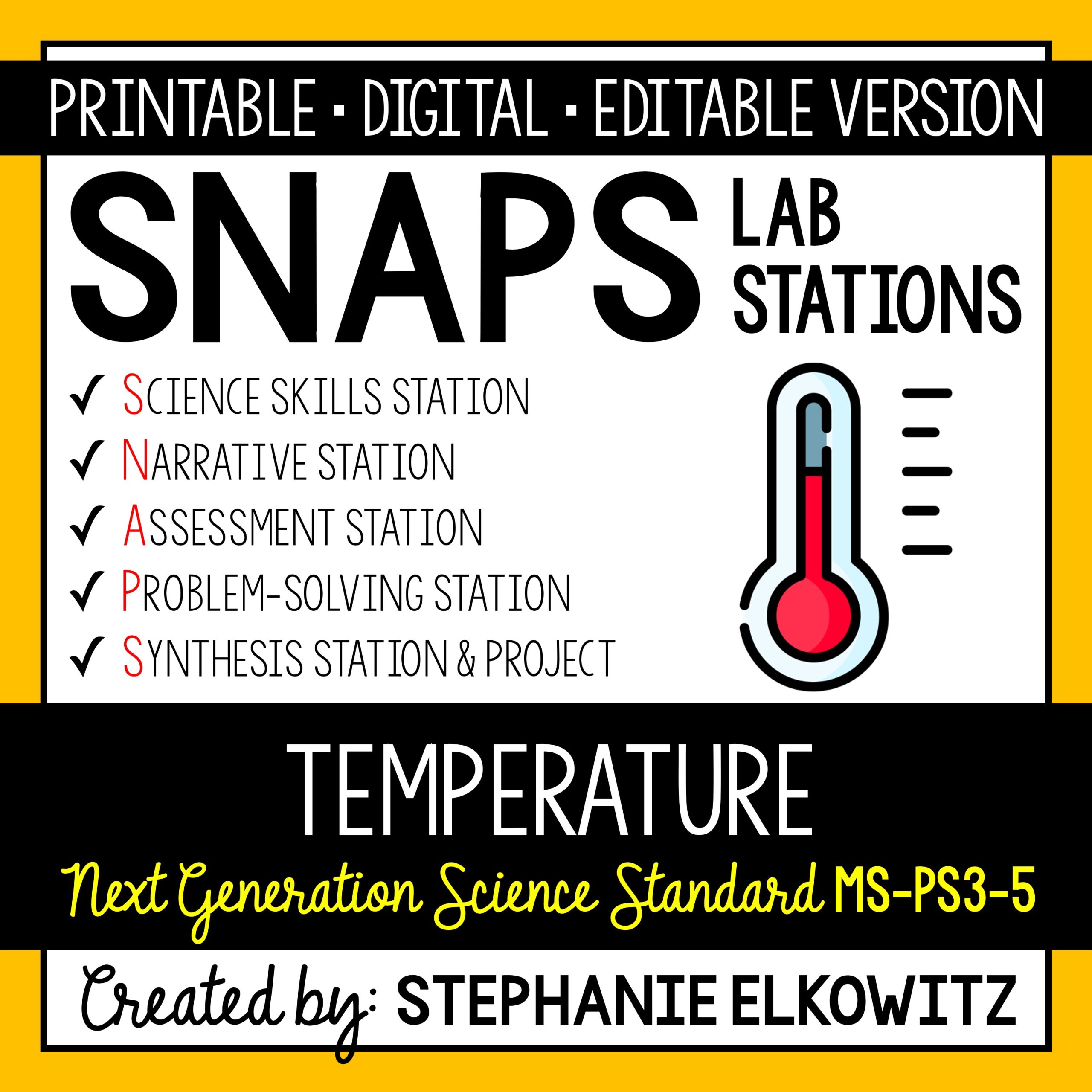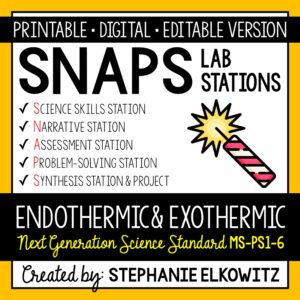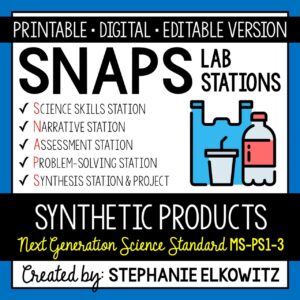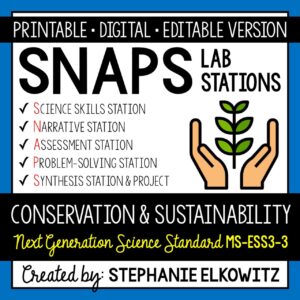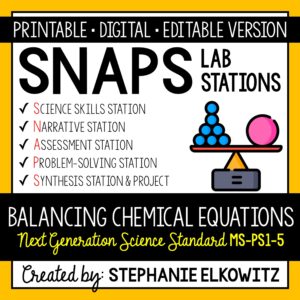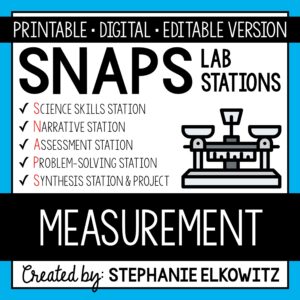MS-PS3-4 Thermal Energy Lab
$7.00
An engaging lab activity designed to enhance students’ understanding of how mass, chemical composition and temperature change determine the amount of thermal energy transferred to or from a substance. Aligned with NGSS MS-PS3-4.
Description
MS-PS3-4 Thermal Energy Lab Preview
SNAPs Lab Stations Activities require students to use science, math, literacy, problem-solving and engineering skills. They are designed to enhance students’ understanding of scientific concepts and help students apply scientific ideas to the real world. Each station activity promotes skills so to develop students into proficient and competent scientific thinkers.
SNAPs lab activities have five components:
• Science Skills Station to develop science skill proficiency
• Narrative Station to build science literacy
• Assessment Station to evaluate learning and understanding
• Problem-Solving Station to foster engineering design
• Synthesis Station and Project to inspire higher-order learning
DIGITAL LABORATORY – DISTANCE LEARNING & DIGITAL CLASSROOMS
• This lab is offered in a digital format to support digital classrooms & distance learning.
• The digital lab activity is designed to work with Google Slides and Microsoft PowerPoint
• The digital lab activity CANNOT be edited. However:
– Students can manipulate text boxes
– Students can create tables, graphs and diagrams
– Students can insert images and drawings
GOOGLE FORM ASSESSMENT STATION
• The assessment station is offered as a self-grading Google Form.
• Questions are all short answer and are 100% editable.
• Suggestions for use are included in the download.
DISTANCE LEARNING COMPATIBILITY
SNAPs lab activities are rated for their ease with distance – independent learning. Refer to the preview for more information about how well this laboratory works in a fully digital classroom and with distance learning.
EDITABLE DOCUMENTS
This download includes an editable word document (docx file) of all lab components:
• Pre-Lab and Post-Lab Activities
• The Lab Overview
• Lab Station Activities and Questions
• Directed Synthesis Project (when applicable)
Important Notes:
• Diagrams, illustrations, tables and graphs essential to lab activities are included
• Illustrative clipart is NOT included
• Editable documents and rubrics are included with the FREE SNAPs Setup Guide
Editable files allow you to:
• Edit the scope of the activities so to suit your students’ needs
• Edit the materials required based on resource availability
• Create single-period “mini-labs” using activities at the individual skills stations
The activities at each station in this lab are detailed below.
Thermal Energy Lab Stations Activity Learning Objectives
1. Conduct an investigation so to observe how mass and chemical composition impact the temperature change of a substance when thermal energy is transferred to or from that substance.
2. Explain how mass, chemical composition and temperature change determine the amount of thermal energy transferred to or from a substance.
3. Use a mathematical model to study the relationship between mass, chemical composition, temperature change and the amount of thermal energy transferred to or from a substance.
Science Skills Station
Students will conduct controlled experiments to compare temperature changes in different experimental groups. First, students will investigate how temperature changes for different substances with the same mass when the same amount of thermal energy is transferred to those substances. Second, students will investigate how temperature changes for samples of the same substance with different masses when thermal energy is transferred to those samples.
Narrative Station
Students will read a text about how we study temperature change and how the amount of thermal energy an object possesses depends on more than just its temperature. Students will also watch a video about the factors that determine how much thermal energy a substance or material has.
Assessment Station
At this station, students will answer questions about key terms and ideas relating to the factors that impact the amount of thermal energy contained within a substance. Students must employ lower, mid and higher order thinking skills to answer these questions.
Problem-Solving Station
Students will use a mathematical model to quantify the relationship between the thermal energy transferred to or from an object, mass, chemical composition and temperature change.
Synthesis Station
Students will compose a CER (claim-evidence-reasoning) report to summarize the lab. Students are provided the claim statement and must support the claim with observations, data and other information gathered in the lab. Students will explain how the evidence supports the claim using scientific reasoning.
Synthesis Project
Students will have a choice of 11 projects. Refer to the SNAPs Lab Stations Best Practices and Setup Guide for directions and suggestions on how to conduct the project.
This download includes:
• A pre-lab assignment and post-lab reflection
• Directions and questions for each lab station
• Student recording sheets
• Teacher Key
Additional Materials Required:
1 Computer or tablet
1 Calculator
3 600 mL beakers
Graduated cylinder
Thermometer
1 large hotplate or 3 small hotplates
Stirring rod
Stopwatch
Tongs
Oven mitts or gloves
Water
Acetic acid
Canola oil
Two metal containers (such as empty 30.5 oz coffee tins with lids)
Colored pencils
LINKS TO VIDEOS
This laboratory requires internet to access videos. Videos are hosted on SafeShare.TV so to safely watch and share educational YouTube videos without ads, comments and other distractions. Link(s) to SafeShare.TV included. Full link to original YouTube video(s) included.
NEXT GENERATION SCIENCE STANDARDS
This laboratory satisfies NGSS MS-PS3-4. It combines the three dimensions of science learning – science and engineering practices, disciplinary core ideas and crosscutting concepts – to meet the standard. This lab also makes interdisciplinary connections to STEM, Math CCSS and ELA CCSS to build the appropriate skills.
TERMS OF USE
• All rights reserved by Stephanie Elkowitz.
• This product is to be used by the original purchaser only.
• Intended for classroom and personal use only.
• Copying for more than one teacher, classroom, department, school, or school system is prohibited.
• This product may not be distributed or displayed digitally for public view.
• Failure to comply is a copyright infringement and a violation of the Digital Millennium Copyright Act (DMCA).

